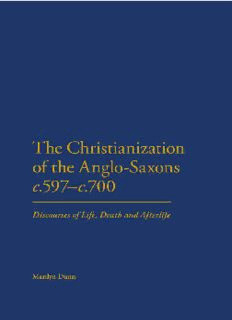
The Christianization of the Anglo-Saxons, c. 597-700: Discourses of Life, Death and Afterlife PDF
Preview The Christianization of the Anglo-Saxons, c. 597-700: Discourses of Life, Death and Afterlife
THE CHRISTIANIZATION OF THE ANGLO-SAXONS C.597–C.700 This page intentionally left blank The Christianization of the Anglo-Saxons c.597–c.700 Discourses of Life, Death and Afterlife Marilyn Dunn Continuum UK, The Tower Building, 11 York Road, London SE1 7NX Continuum US, 80 Maiden Lane, Suite 704, New York, NY 10038 www.continuumbooks.com Copyright © Marilyn Dunn 2009 All rights reserved. No part of this publication may be reproduced or transmitted in any form or by any means, electronic or mechanical, including photocopying, recording or any information storage or retrieval system, without prior permission from the publishers. First published 2009 British Library Cataloguing-in-Publication Data A catalogue record for this book is available from the British Library. ISBN 978 1 84725 189 3 Typeset by Pindar NZ, Auckland, New Zealand Printed and bound by MPG Books Ltd, Cornwall Contents List of Abbreviations vii 1 Approaches to the Christianization of the Anglo-Saxons 1 2 Discourses of the Dead: Popular Intuitions, Christian Doctrines and Epidemic Disease 7 3 Gregory the Great and the English Mission 43 4 Anglo-Saxon Paganism and the Living 57 5 Anglo-Saxon Paganism and the Dead 85 6 The Diffusion Of Christianity and the Establishment of the Anglo-Saxon Church 101 7 Christianization: Problems and Responses 135 8 How Christian Was Anglo-Saxon England c.700? 187 Notes 195 Bibliography 249 Index 269 For MB List of Abbreviations AHR American Historical Review ANF Ante-Nicene Fathers ASSAH Anglo-Saxon Studies in Archaeology and History BAR British Archaeological Reports CBA Council for British Archaeology CCSL Corpus Christianorum Series Latina HE B. Colgrave and R. Mynors (eds and trans.), Bede’s Ecclesiastical History of the English People Jesuit Relations R. G. Thwaites (ed.), Jesuit Relations and Allied Documents NPNF1st ser. Nicene and Post-Nicene Fathers First Series NPNF2nd ser. Nicene and Post-Nicene Fathers Second Series PL J-P. Migne (ed.), Patrologia Cursus Completus Series Latina RHE Revue d’Histoire Ecclésiastique SC Sources Chrétiennes Antonine Clyde Wall Ba Coldingham Melrose TGwelemednburgh LFinardnisef aIsrlnaends bernYiecaveiraing CarlisHlaWedarli‘laHn’seaHveenxfihGealamdte’sThynenaedarJMaroronwkwearmouth e rheged oW Hartlepool r Gillingt Whitby h man SCwaatlteerick umdeLiarstiangham Ripon Nidd briYw oentrk Goodmanham Leeds elameDert Beverley Campodonum anglesey HatfieldTrent lindsHeumyber g w yn Lincoln Bardney e dd Bangor Oswestry North Elmham Lichfimeldiddle PgeyterrbwoerougheaBusrgth Castle angles mercia EalynglDuinawich Rendlesham hwWiocrccesteer Hertford saexaostns Sutton Hoo St Albans Hatfield Bradwell Dorchester London Barking Malmesbury Tha Thanet west mes RochesCtearnterbury Reculver saxons Winchester kent Finglesham dumnonia Apple Down south saxons Bosham isle SolentSelsey of wight Principal places mentioned in the text 1 Approaches to the Christianization of the Anglo-Saxons The diffi culties of studying the religions of the Anglo-Saxons in the conversion period are well known. Historians have agonized over the basic and ‘fearsome question of how religious activity is to be identifi ed in the surviving record’.1 Such are the problems associated with both the quantity and the quality of the written and material record that, despite the existence of several studies of Anglo-Saxon paganism, one commentator has been driven to conclude that . . . the essential known is the historical and that the historical, in terms of Anglo-Saxon religion, means Christian culture.2 A judgement of this nature implies that any view of the process of Christianization itself is always going to be written predominantly from the Christian side: and indeed several existing works on the topic have been written largely – though not always entirely – from this perspective.3 But should we necessarily be content with such a restrictive approach? While the problems confronting the historian are extensive, we might look at the issue from another angle, attempt ‘to make contact with otherness in other cultures’, and establish a more anthropological approach to the history of the Anglo-Saxon ‘conversion period’.4 What sort of religion was Anglo-Saxon paganism? What type of belief-system is Christianity? If we can achieve some understanding of the differences and also of the similar- ities which existed between them, a fresh understanding of the nature and extent of Christianization might be possible. The following study sets out to examine paganism, Christianity and the encounter between them in Anglo-Saxon England in the period c.597 to c.700 by analysing them as different types of religion. The study of religions as religions is hardly new. One of the best-known infl uences on the creation of a typology or typologies of religion is Max Weber (1864–1920), some of whose work explored religious rejections of the world and their different ‘directions’.5 Weber suggested that, because of their overriding goal of salvation, ‘world rejecting’ religions (which are also ‘rationalized’ religions, providing answers to profound questions of meaning) exist in a state of tension with the political, economic, familial, sexual, aesthetic, scientifi c and intellectual aspects of society. Religions of this type produce a highly negative valuation of human civilization along with the goals of detachment from society and the
